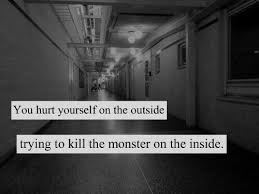Salam (May God Bless you). Static means standing still. In case of electricity we mean to say that electricity does not just pass on in a matter of moments through an object, like everyone believes, electricity can also be stored or built up in an object or more specifically an insulator. The reason for this is that most conductors are metal and metals have a sea of valence electrons in its lattice. These electrons are mobile and thus can carry charge around the whole metal causing the electrical energy to pass on quickly. An insulator is deprived of this much electrons causing the electrical charge to build up in it.
Static Charge by FrictionStatic charge is mostly done by friction. Friction is the resistive force against any 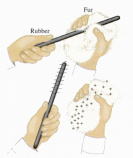 moving object. This force causes the formation of electricity which builds up in an insulator. If you walk on a nylon carpet and touch a door knob, you will feel a tingle on your finger, this is due to discharge of the electrons from your finger. Even in our atmosphere static electricity is produced. The warm and cold bodies of air pass through each other and due to the friction of their movement static electricity is formed, when it is formed in excess, it is then discharged in the form of lighting, this is also accompanied by an explosion we call thunder.
moving object. This force causes the formation of electricity which builds up in an insulator. If you walk on a nylon carpet and touch a door knob, you will feel a tingle on your finger, this is due to discharge of the electrons from your finger. Even in our atmosphere static electricity is produced. The warm and cold bodies of air pass through each other and due to the friction of their movement static electricity is formed, when it is formed in excess, it is then discharged in the form of lighting, this is also accompanied by an explosion we call thunder.
What happens when you rub two insulators is that, when they are rubbed off, electrons are passed from one insulator to the other insulator, leaving one object positively charged while the other negatively charged. The charge the both objects carry is equal but opposite.
Two types of chargesThere are two types of charges one being negative and the other positive. We can see the effects of such charges by charging two glass rods with silk and placing them together, we can see that they repel each other. If we charge an ebonite rod and place it in front of a glass rod, they attract each other. We can say that two carry an opposite charge, while the two glass rods carried the same charge.
When a positively charged object is touched, the electrons will flow into the  charged object from earth. When a negatively charged object is touched, the electrons flow from the object and into the earth. This is a simple method of discharging an object.
charged object from earth. When a negatively charged object is touched, the electrons flow from the object and into the earth. This is a simple method of discharging an object.
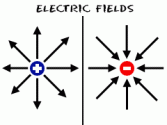 A positive charge has currents flowing outwards, while a negative charge has current flowing towards it. If you put two objects which have the same charge the two charges will repel each other but the charges which are opposite will attract each other.
A positive charge has currents flowing outwards, while a negative charge has current flowing towards it. If you put two objects which have the same charge the two charges will repel each other but the charges which are opposite will attract each other.
The Ancient Greeks first noticed that when amber was rubbed on a fur, it would gain unusual properties. The amber could attract small pieces of various objects. 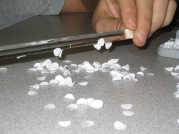 In the 16th century, the famous physicist Dr. William Gilbert, then observed this property much more closely.
In the 16th century, the famous physicist Dr. William Gilbert, then observed this property much more closely.
What happens is that if a positively charged object such as perspex ruler is placed on top of a few bits of paper, the bits would be attracted to the object. This is because the papers have an equal and opposite charge in them. Meaning it has both the positive and negative charge which is evenly distributed across the paper.
When the ruler is placed on top of it, the negative charge moves towards the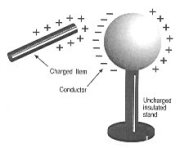 side where the ruler is and the concentration of the negative charge is increased on one side of the paper while on the other side the positive charge is in higher concentration. This causes attraction between the two things. This whole process is called electromagnetic induction.
side where the ruler is and the concentration of the negative charge is increased on one side of the paper while on the other side the positive charge is in higher concentration. This causes attraction between the two things. This whole process is called electromagnetic induction.
A van der Graaf is large insulated metal dome which uses static electricity to 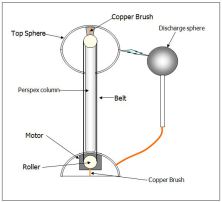 charge itself. It is charged by a rubber rubbing off on a perspex bar. If you touch it while standing on an insulator, your body will be charged.
charge itself. It is charged by a rubber rubbing off on a perspex bar. If you touch it while standing on an insulator, your body will be charged.
The reason your hair looks strange is because every single hair is charged the same and will repel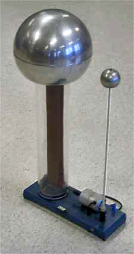 each other. There is a smaller sphere near the van der Graaf which is connected to the earth, it will take away the electrons of the Van der Graaf.
each other. There is a smaller sphere near the van der Graaf which is connected to the earth, it will take away the electrons of the Van der Graaf.
An electroscope is a piece of apparatus. It is useful to check whether an object is charged or not. It consists of a brass cap, a brass rod and a brass plate. The brass rod is insulated from the metal jar. The jar is covered in glass and is earthed. There is a metal leaf with the brass plate which is normally made of gold. If a positively charged object is placed above the brass cap, electrons will flow into the brass cap 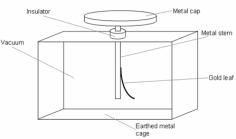 using the same principle as the electrostatic induction.
using the same principle as the electrostatic induction.
The brass plate and the metal leaf will both be positively charged which will cause them to repel. In case of a negatively charged object, same effect occurs, only that the brass cap will be positively charged while the metal leaf and the brass plate will be negatively charged. 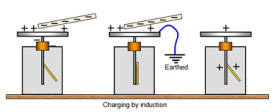
If you touch the brass plate or just connect it to the earth directrly during the experiment, the electrons will flow into the earth, causing the electroscope to be positively charged entirely, this will cause the metal leaf and the brass plate to repel. The same effect occurs when using a negatively charged object, only difference is that the electrons will flow in to the electroscope from the earth in this case.
Share this:


